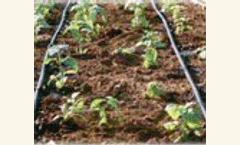Crop Model To Simulate Yield Articles & Analysis: Older
10 articles found
Agriculture degrades over 24 million acres of fertile soil every year, raising concerns about meeting the rising global demand for food. But a simple farming practice born from the 1930's Dust Bowl could provide a solution, according to new Stanford research. The study, published Dec. 6 in Environmental Research Letters, shows that Midwest farmers who reduced how much they overturned the soil -- ...
Laboratory and soil-plant-air-water analysis showed silt-loam being the most dominant soil type in the study area. A yield simulation model, AquaCrop, was able to simulate the crop yield with reasonable accuracy. Future (2030–2060) crop yield ...
Deficit irrigation can be applied in the field to save irrigation water and still lead to acceptable crop production. The AquaCrop model is a simulation model for management of irrigation and nitrogen fertilizer. ...
An analysis of spatial and temporal variation of drought impact may offer an unbiased glimpse into factors that may dictate drought severity at an apt local scale. In this study drought indices, for example, drought severity and coverage index, ISC, and, a derived crop–based drought severity and coverage index, ISC,AG, were scaled down to county levels. Drought frequency analyses showed clear ...
The study was based on long-term climatic and crop productivity data, regional climatic scenarios and a crop simulation model. ...
The AquaCrop model was developed to replace the former FAO I&D Paper 33 procedures for the estimation of crop productivity in relation to water supply and agronomic management in a framework based on current plant physiological and soil water budgeting concepts. ...
This work was aimed at determining the optimum level of applied irrigation water (AIW) for cotton (Gossypium hirsutum L.) production in southern Spain under several climatic and agricultural policy scenarios. To generate the yield response to variations in AIW, we used the FAO crop water productivity (WP) model, AquaCrop. Model ...
The first crop chosen to parameterize and test the new FAO AquaCrop model is maize (Zea mays L.). ...
This article introduces the FAO crop model AquaCrop. It simulates attainable yields of major herbaceous crops as a function of water consumption under rainfed, supplemental, deficit, and full irrigation conditions. ...
There is scope internationally to utilise surplus and degraded agricultural land for biomass crops that might also be environmentally beneficial. For example, dryland salinity in southern Australian could be ameliorated using profitable woody biomass crops. A model was developed to predict biomass production from such woody crops. At a biomass price of A$35/t (green) and a water use efficiency of ...





